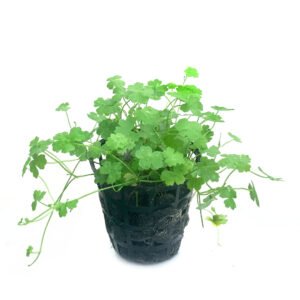Rotala Tulunadensis
Rotala Tulunadensis
#GWAE122
₹500 Original price was: ₹500.₹200Current price is: ₹200./-
Additional information
| Light Requirement | |
|---|---|
| Plant Difficulty | |
| Plant Type |
– Rotala tulunadensis forms dense mats when conditions are favorable, creating a lush, green cover.
– It prefers nutrient-rich substrates and can benefit from CO2 supplementation in an aquarium setting.
– This species thrives in high light conditions but can adapt to moderate light as well.
Care Tips:
– Light: Prefers high light for optimal growth and coloration.
– Substrate: Nutrient-rich substrate is recommended for vigorous growth.
– Water Conditions:Grows well in soft to moderately hard water with a pH range of 6.0-7.5.
– Fertilization: Regular fertilization with micronutrients and macronutrients will enhance growth and coloration.
-CO2:Supplementing with CO2 can promote faster growth and more vibrant colors.
Uses:
– Ideal for aquascaping due to its attractive appearance and growth habit.
– Can be used in both emersed and submersed conditions, making it versatile for various aquatic setups.
– Rotala tulunadensis forms dense mats when conditions are favorable, creating a lush, green cover.
– It prefers nutrient-rich substrates and can benefit from CO2 supplementation in an aquarium setting.
– This species thrives in high light conditions but can adapt to moderate light as well.Care Tips:
– Light: Prefers high light for optimal growth and coloration.
– Substrate: Nutrient-rich substrate is recommended for vigorous growth.
– Water Conditions:Grows well in soft to moderately hard water with a pH range of 6.0-7.5.
– Fertilization: Regular fertilization with micronutrients and macronutrients will enhance growth and coloration.
-CO2:Supplementing with CO2 can promote faster growth and more vibrant colors.Uses:
– Ideal for aquascaping due to its attractive appearance and growth habit.
– Can be used in both emersed and submersed conditions, making it versatile for various aquatic setups.
Out of stock
Out of stock
Details
Common Name: Tulunadu Rotala
Scientific Name:Rotala tulunadensis
Family: Lythraceae
Origin:Tulu Nadu region, Karnataka, India
Description:
Rotala tulunadensis is an attractive aquatic plant that thrives in wet, marshy environments. When grown emersed (above water), it exhibits unique characteristics that make it a favorite among aquarists and botanists alike.
Stems:
– The stems are slender, erect, and can grow up to 20-30 cm tall when emersed.
– They are typically green but can take on reddish hues under high light conditions.
Leaves:
– Leaves are arranged oppositely along the stem.
– The shape of the leaves is typically lanceolate to ovate, with a smooth margin.
– Leaf color ranges from bright green to reddish, depending on light intensity and nutrient availability.
– Leaves are sessile, meaning they attach directly to the stem without a petiole.
Flowers:
– Flowers are small, usually axillary, and can form in clusters.
– Each flower has four to five petals that are typically white or pale pink.
– Flowering occurs above the water surface, adding a delicate beauty to the plant.
Growth Form:
– Rotala tulunadensis forms dense mats when conditions are favorable, creating a lush, green cover.
– It prefers nutrient-rich substrates and can benefit from CO2 supplementation in an aquarium setting.
– This species thrives in high light conditions but can adapt to moderate light as well.
Care Tips:
– Light: Prefers high light for optimal growth and coloration.
– Substrate: Nutrient-rich substrate is recommended for vigorous growth.
– Water Conditions: Grows well in soft to moderately hard water with a pH range of 6.0-7.5.
– Fertilization: Regular fertilization with micronutrients and macronutrients will enhance growth and coloration.
– CO2: Supplementing with CO2 can promote faster growth and more vibrant colors.
Uses:
– Ideal for aquascaping due to its attractive appearance and growth habit.
– Can be used in both emersed and submersed conditions, making it versatile for various aquatic setups.
Propagation:
– Propagation is typically done through cuttings. Simply cut a healthy stem and replant it in the substrate.
Rotala tulunadensis is a beautiful addition to any aquatic plant collection, offering vibrant colors and unique growth patterns that enhance the visual appeal of emersed and submersed setups alike.
Related products
Related products
-
20%
OFF

Hydrocotyle tripartita ‘Mini’
₹150Original price was: ₹150.₹120Current price is: ₹120./- Add to cart4 in stock
-
17%
OFF

Staurogyne repens
₹120Original price was: ₹120.₹100Current price is: ₹100./- Read moreOut of stock
-
27%
OFF

Microsorum pteropus “Java fern”
₹275Original price was: ₹275.₹200Current price is: ₹200./- Add to cart5 in stock
-
10%
OFF

Ammania Pedicellata ‘Golden’
₹100Original price was: ₹100.₹90Current price is: ₹90./- Add to cart5 in stock





